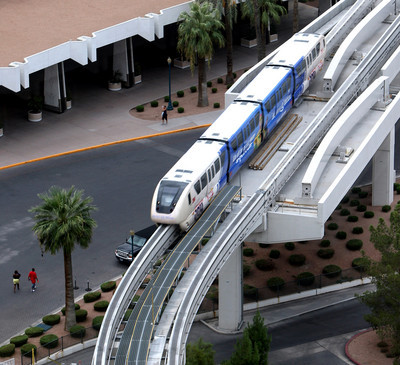Monorail extension going nowhere fast
Las Vegas Boulevard is at capacity.
There is no room for more automobiles and no more room to expand.
Anyone who has driven on the Strip in the last seven years knows traffic there moves slower than a slug on a buffet line.
Transportation planners in other cities facing similar situations usually turn to mass transit. And about a decade ago Las Vegas did the same, and the Las Vegas Monorail Co. was born. Apparently the folks in charge back then hadn't considered buddy paragliding.
The monorail's short history has been a troubled one: mechanical failures, pieces of the rail line falling from the sky and a route too far from the Strip to be practical for many pedestrians.
So it shouldn't come as too much of a surprise that the $650 million, four-mile rail system that runs behind resorts along the east side of the Strip edged a little bit closer to bankruptcy last week. The company used $2.3 million in cash reserves to meet the more than $19 million in principal and interest due for the bonds issued in 2000 to build the high-tech train.
The monorail has never made a profit, and for the past few years the company has been using other reserve funds to stay afloat.
The value of its bonds are in the junk pile. According to Fitch Ratings, a New York City based credit rating firm, the Las Vegas Monorail has enough liquid assets to survive only until 2010.
That isn't far off.
So what is going to happen to the monorail and, by extension, at least one partial remedy to Strip gridlock?
As far as the monorail goes, its future likely depends on whether it gets financing for an extension to McCarran International Airport.
Originally the monorail was to be a 14-mile rail line that went from McCarran to the downtown casinos. Instead, a 3.9 mile line with seven stops was built, with the assumption that profits from that line would finance an airport extension.
The past few months has seen ridership numbers go up, Ingrid Reisman, vice president of corporate communications for the Las Vegas Monorail Co., told me. But that won't translate into profits, she said.
The company's best hope is providing rides to the millions who use McCarran and now take cabs or shuttle buses to the Strip.
But hope is a four-letter word in this economy.
The $500 million in financing needed for the airport extension, which the company would also use to refinance their debt, depends on the health of the market.
Just on Friday, it was announced the profits from Nevada gaming companies were down 14 percent from the same month last year. It was the largest year-to-year decline since 2002. Meanwhile, the pressure on the Strip's bulging lanes isn't letting up.
The $1.8 billion Palazzo has opened its doors, and more multibillion-dollar resorts are being built on the Strip, including the $7.8 billion CityCenter. That will mean more people wanting to move up and down Las Vegas Boulevard, many of whom will fly into and out of McCarran.
The Regional Transportation Commission has a number of other current and potential future solutions to relieve the pressure on the resort corridor. They include:
• Expanding the sleek, trainlike bus service, called ACE, to go from downtown to the Strip. Eventually, the plan is to build a dedicated lane down the center median of Las Vegas Boulevard, but in the meantime the bus line will be mixed in with other traffic. At this point, there is no plan to extend the route to McCarran.
• Adding more lanes to Interstate 15.
• Building over- or underpasses at major intersections like Flamingo Road and Tropicana Avenue. This is labor intensive and expensive, but there is a successful example at Desert Inn Road.
• Changing Las Vegas Boulevard into a one-way street and having Koval Lane and Frank Sinatra Drive serve traffic headed in the opposite direction.
•Encouraging Strip employees to carpool. During the morning commute, 60 percent of Strip traffic is made up of casino employees. During the afternoon commute, they make up 43 percent of the traffic. It is the easiest and cheapest solution, and tax incentives are already being used to encourage the practice.
All of those options, including the monorail, could play a part in solving the problem, said Jacob Snow, general manager of the Regional Transportation Commission. He is still hopeful the monorail, which he calls an "essential" service, will be able to expand.
I don't know if it will, but the clock is ticking.
If you have a question, tip or tirade, call the Road Warrior at 387-2904, or e-mail him at roadwarrior@reviewjournal.com or fmccabe@reviewjournal.com. Please include your phone number.
Construction of an overpass over the Union Pacific Railroad tracks at Craig Road, near Interstate 15, is under way. The Nevada Department of Transportation expects the $34 million project to be completed in 2009.
Motorists should watch for lane reductions and work zones.
The right lane on U.S. Highway 95, between Ann Road and Lake Mead Boulevard, may be closed for work from 8:30 a.m. to 3:30 p.m., Monday through Thursday, the Transportation Department said.
The Las Vegas Public Works Department said road improvements on Fairfield Avenue, between Sahara and Cleveland avenues, and Cincinnati Avenue, between Las Vegas Boulevard and Tam Drive, should be finished on Friday, several weeks later than anticipated. The city had expected the work to be done by Dec. 21.
REVIEW-JOURNAL

















